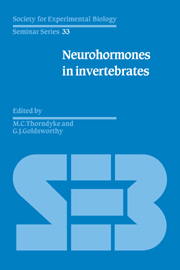Book contents
- Frontmatter
- Contents
- List of contributors
- Preface
- What is special about peptides as neuronal messengers?
- Part I Immunocytochemistry and Ultrastructure
- The new neurobiology – ultrastructural aspects of peptide release as revealed by studies of invertebrate nervous systems
- Immunocytochemistry of hormonal peptides in molluscs: optical and electron microscopy and the use of monoclonal antibodies
- Immunocytology of insect peptides and amines
- Immunocytochemistry and ultrastructure of crustacean endocrine cells
- Part II Arthropod Neurohormones
- Part III Neurohormones in Coelenterates, Annelids and Protochordates
- Part IV Neurohormones in Molluscs
- Index
The new neurobiology – ultrastructural aspects of peptide release as revealed by studies of invertebrate nervous systems
Published online by Cambridge University Press: 04 August 2010
- Frontmatter
- Contents
- List of contributors
- Preface
- What is special about peptides as neuronal messengers?
- Part I Immunocytochemistry and Ultrastructure
- The new neurobiology – ultrastructural aspects of peptide release as revealed by studies of invertebrate nervous systems
- Immunocytochemistry of hormonal peptides in molluscs: optical and electron microscopy and the use of monoclonal antibodies
- Immunocytology of insect peptides and amines
- Immunocytochemistry and ultrastructure of crustacean endocrine cells
- Part II Arthropod Neurohormones
- Part III Neurohormones in Coelenterates, Annelids and Protochordates
- Part IV Neurohormones in Molluscs
- Index
Summary
Ultrastructure of invertebrate nervous systems
Neuroecretory and other neurons
Examination of invertebrate nervous systems reveals that many are richly endowed with neurones resembling classical neurosecretory cells in cytology and ultrastructure. Such cells are clearly specialized for peptide secretion. They contain an abundance of rough endoplasmic reticulum (RER), and secretory granules (variously known as elementary granules, large dense-cored vesicles, etc.) generated by Golgi bodies, accumulate in large numbers within the perikarya. Although many are doubtless endocrine cells, others (Figs. 1-3) have axons which extend not to blood cavities, but into the central neuropile where the secretory material is discharged.
Furthermore, some secretory granules are evident in virtually all neurones (Golding & Whittle 1977), and this is consistent with the finding that many and perhaps all neurones, including those with conventional transmitters, also secrete peptides (review by Hokfelt, Johansson & Goldstein 1984).
Nerve terminals: vesicles and granules
In most nerve terminals, whether in the central or peripheral nervous systems, large numbers of synaptic vesicles are encountered (Figs. 4 & 5). Measuring 20-50nm in diameter, the vesicles in all but a small minority of terminals (Fig. 6) have lucent contents, except following exposure to a mixture of Zinc iodide and Osmium tetroxide (the ZIO reagent) (Fig. 7) which deposits extremely electrondense material within them (May & Golding 1982). The vesicles cluster densely adjacent to sites of specialized contact with other cells. Pre- and postsynaptic thickenings are present and the synaptic clefts are wider and often more regular in form than other intercellular spaces, and contain moderately dense material.
- Type
- Chapter
- Information
- Neurohormones in Invertebrates , pp. 7 - 18Publisher: Cambridge University PressPrint publication year: 1988
- 7
- Cited by



